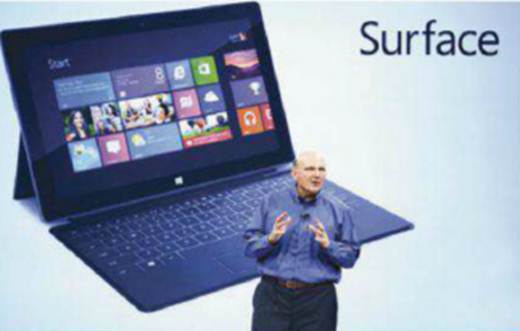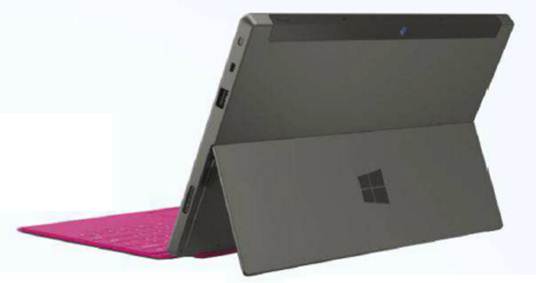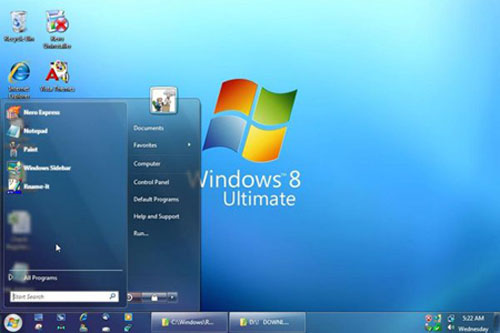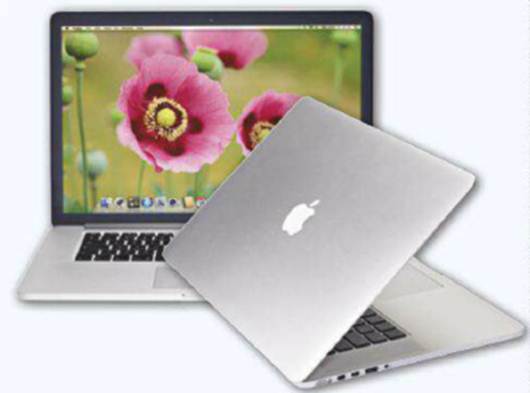We’re cynical about Microsoft’s
surface announcements, and is impressed by the new Macbook pro’s retina
display.
We're in what was supposed to be a calm
before the storm-surge of the Windows release, but it's nevertheless been
extraordinarily busy on the hardware front. Where to start? Well there was much
cooing and swooning at the Surface news, mostly because Microsoft isn't known
for making hardware - if you're prepared to ignore the mouse and keyboard
marketplace, that is. Oh, and let's not forget the custom-built servers it's
made for its data centres.
Alright, so no hardware apart from those
three. Did I mention the Xbox? And the Kinect controller? Actually, when you
look at it closely, PCs and laptops are one of the few areas where Microsoft
doesn't currently sell its own hardware. Mobile phones is another, although one
might argue that Nokia has become a quasi-dependent subsidiary through its
commitment to Windows Phone. But if you leave aside all these areas, it's
apparently big news that Microsoft is going to do a tablet.
Perhaps Microsoft has only itself to blame.
As I tweeted at the time: "Apple announces. Apple ships. Google announces.
Google ships. Microsoft announces. Can't even tell you the battery life,
QED", which, although harsh, is fair. Apple always has products ready to
ship, often on the same day as the announcement. Google announced its new
tablet PC and was shipping it within a week or two. Microsoft announces
Surface, but can only commit to shipping the ARM RT version somewhere around
the release date of Windows 8 itself, with the Intel version following around
three months later.
The OEM hardware manufacturers have come
under intense criticism, too. It's been claimed that Microsoft may have decided
to do the Surface tablet because of disappointment with the OEM's offerings.
I've heard this from various sources, and while it may be true, it also seems
incredibly unfair. You might recall that back in January, I reported from the
CES in Las Vegas that there was nothing there for Windows 8 - nothing from
Microsoft, and no hardware of significance from any OEM vendors. This was
entirely to be expected, because what company would want to unveil designs in
January for a product that it couldn't ship until October? Remember that
hardware has a shelf life of some six to eight months at best nowadays, so
that's a generation in hardware terms.
Roll forward to Computex in Taipei and a
few vendors showed hardware, but mostly in a tentative way, and the
commentators still blasted them for not showing more despite the shipping date for
Windows 8 remaining a great unknown. Worse still, Intel had only just started
shipping the Ivy Bridge chipset, which is arguably a necessary piece of the
puzzle required for Intel- based touchscreen devices to achieve half-decent
battery life. And now here we are, months before the official Microsoft release
date, when vendors finally have the tools to build devices for an October
release.

Most
companies are ready to ship their tablets straight after the announcement - not
Microsoft.
But no, Microsoft isn't happy with that
timescale - that would be far too easy. It has decided to go with what's
effectively an early-2013 hardware ship date for its Intel product. Why would
it want to do that? Well, there's a rumour doing the rounds that Intel's next-
generation chipset will be ready by then and that this will significantly
improve battery life - which, as I've just said, is a major problem area for
Intel- based tablets and Ultrabooks. That's why Microsoft won't give us battery
life figures today for Surface because if it did, they'd be based on Ivy Bridge
and it wants to quote next-generation hardware lives if at all possible.
Never mind those poor OEMs that have signed
up to have hardware ready for the Windows 8 launch this autumn. The ones that
now can't wait to see whatever Intel has up its sleeve next. Worse still, they
know that businesses, which are the prime target for the Intel version of the
Surface product, will probably hang on to see what Microsoft itself will
deliver. After all, a Microsoft operating system running on a Microsoft device
leaves no wriggle room for Microsoft - it will be judged ruthlessly on what it
ships. I do hope Microsoft has pulled the best people together at Pegatron,
which is rumoured to be the ODM (original design and manufacture) partner.
Who'd want to be an OEM hardware vendor in
the middle of this perfect storm? According to some reports, the heads of
certain OEMs weren't told by Microsoft about its plans until minutes before the
announcement. I can imagine how well that news was received.
Surface tension
Now let's consider the whirlwind of spin
that surrounds the name "Surface". You might recall this term was
originally used for a large interactive table-top display, where the whole
table surface was the working area. Designed for multi-user input, or for large
areas such as hotel check-ins, this concept has gone through several
generations of hardware realization, with Samsung creating a large, custom TFT
panel that can "see" upwards at pixel level to detect what objects
have been placed on it.
This whole project has now been
unceremoniously kicked out of the pram by Microsoft, its name taken away and
plonked down as branding for the Windows 8 project. The older project has been
renamed "PixelSense" and parked under its own domain name of www. pixelsense.com

The
Surface’s clip-on keyboard features some interesting technology inside.
Is there anything particularly interesting
in the design of the Surface devices as shown so far by Microsoft? To be
honest, not really. They make big claims about the material from which its case
is made, but you can tell this is scraping the barrel. Of particular
significance is its clip-on keyboard, using a technology Microsoft first used
for a gaming keyboard, There's definitely interesting stuff going on inside
this keyboard, because it has to be very fast and responsive, and has to
present a good touch and feel despite having almost zero key travel. I'd
discount comments made so far by people who claim to have felt it: let's wait
to see what actually ships from the factory in production form.
But it's the whole need to have a keyboard
attached at all that I find quite fascinating. The reality is that Windows 8
running on a touchscreen device is actually quite a horrible typing experience,
far worse than an iPad. Why is this? Well, because iPad applications have all
been designed from scratch to work with a defined size and layout of system
keyboard, whereas Windows applications haven't, With Windows 8 things are
better, but not by much, On the classic desktop, the old problems still occur
despite efforts to cater for various alternative designs of keyboard, including
one that's designed for landscape mode using both thumbs, The problem is still
present on RT applications.
In truth, I find operating my Microsoft
Build conference Samsung tablet awkward, even using the latest builds of
Windows 8, because of this keyboard. Hence my interest in seeing that Microsoft
appears to have recognised this and decided to build a keyboard into the
Surface's cover. It's almost as if, yet again, Microsoft can’t decide what it
wants Windows 8 to be, and rather than focus on doing one thing well has
decided to try to satisfy everybody, all of the time. This runs a significant
risk of ending up with a camel when you were aiming for a racehorse, as the old
saying goes; Microsoft's Surface announcements should be viewed with cynicism.
Microsoft itself, and its online
apologists, cheerfully claim that all of this has been underway for years, that
nothing about Surface was a panicked reaction to a sudden and crippling fear
that the initial launch success of Windows 8 might be stymied by OEMs that
would actually prefer to keep going with Windows 7 on laptops and Ultrabooks.
Talking of which, I hear that the Windows 8 demonstrations at TechEd Europe run
on Ultrabooks had some problems with the multifinger gestures. Here's how it
was reported by our very own Barry Collins: "Demonstrations during the day
had seen two Microsoft presenters struggle to make gesture controls work on
laptop trackpads, with the Start screen intermittently failing to scroll when
the presenters swiped two fingers across the trackpad, for instance.
[Chaitanya] Sareen insisted that the touchpad drivers were still 'very, very
early' and were 'still being refined'."

Trackpad
support in Windows 8 appears to have been mostly forgotten about, being left as
an exercise for the third-party OEMs
"Very, very early"? In the final
preview version of a product that's about to go gold in a few weeks' time? No
sir, that excuse will not do. Trackpad support in Windows 8 appears to have
been mostly forgotten about, being left as an exercise for the third-party
OEMs.
Yet more hardware
In contrast to Microsoft's announcement
without shipping, Apple decided to launch a significant refresh of many parts
of its desktop and laptop hardware ranges during its WWDC (Worldwide Developers
Conference) event in June. The highlight wasn't really this refresh of various
bits and pieces but the arrival of the MacBook Pro with Retina display.
Naturally I ordered one on the spot and
have now spent several weeks playing with it. Be in no doubt that a 2880 x 1800
pixel display on a 15in laptop is utterly staggering. In the same way that the
iPad B's high-resolution screen has made all other tablets look foggy, low
resolution and second-rate, the new screen on the MacBook Pro makes all other
laptop screens seem lit by gas. It isn't only that it's sharp, it's the
incredible clarity and crispness of every item on screen that's utterly
compelling.
To make this happen, Apple pushed the
capabilities of graphics chipsets and GPUs to the very edge of what's possible.
Indeed, it can now be seen that much of the work Intel has been doing on
graphics chipsets and GPUs has been driven by the requirements of its close
friend and partner Apple.
But this isn't all that's new in this
laptop. Apple has made a brave but correct move by increasing the baseline RAM
complement to 8GB, with a 16GB option. There are no spinning disks either, and
you can only choose from various sizes of SSD. The reason for this follows on
from the work done on the MacBook Air: by repackaging the RAM and SSD chips as
motherboard-level components, a great deal of space can be saved.
This approach has its critics. A number of
people have complained that it means you're fully locked into Apple's choices,
with no real room for any third-party device options. That would become an
issue if the prices charged by Apple were old-school rapacious, but that simply
isn't the case anymore.
I went with the faster 2,7GHz processor speed
and the 16GB of RAM, but stayed with the 512GB of SSD. It's a true powerhouse
of a laptop and the new screen will really require Mountain Lion OS X 10.8 to
make best use of it.

The
Retina display makes other laptop screens seem lit by gas.
One final item that caught my eye on the
Retina MacBook Pro is the provision of not one but two Thunderbolt ports, a
most unexpected and welcome development. My experiments with the
previous-generation MacBook Pro driving two 27in Thunderbolt displays and two
12TB Promise arrays has clearly shown that even with the amazing throughput of
Thunderbolt, it's possible to run out of bandwidth quite easily. Providing a
second Thunderbolt port will enable power users to spread the load between two
buses - maybe one 12TB array on one bus for primary workload and a Thunderbolt
display, and a second 12TB array on the second port for display and backup, or
some such arrangement. I've rejigged my desktop now to be based around my
current 27in iMac. To this I attached a second Thunderbolt monitor and the two
12TB arrays.
The new MacBook Pro has one other feature
that must be considered: it has no Ethernet port. As you might expect, most of
the connectivity of these laptops is done now over 802.11n, especially at the
vastly superior 5GHz spectrum slot. Plugging in an Ethernet cable is worth
doing, but I suspect not many people do.